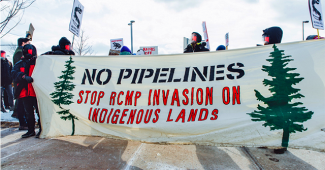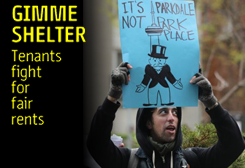OIL SLICK
Is the RCMP up to its old dirty tricks with Wet’suwet’en pipeline protesters?


THEY BURN BARNS, DON’T THEY? It’s a hard fact the RCMP can’t deny and one Wet’suwet’en protesters can’t forget, as they process a report from the RCMP of a “violent confrontation” at the Coastal GasLink construction camp near the Morice River in the B.C. interior on February 17.
The RCMP burned down a barn in Quebec in 1972. They said they did it to prevent a possible crime. They broke the law to uphold the law. It’s an approach they have used more than once. It’s as much a part of RCMP history as horses and red serge dress tunics. Did the force turn to that playbook again at the Coastal GasLink camp?
A ‘calculated and organized event’
According to the RCMP a group of approximately 20 people attacked a Coastal GasLink (CGL) construction site on Wet’suwet’en territory, in the early hours of Thursday, February 17.
The report says the “masked individuals” used an assortment of axes, flares, smoke bombs, and booby traps to destroy several pieces of heavy machinery including an excavator, and attacked security guards and other workers.
Photos released by the company document intense and astounding levels of property destruction: a building shredded, a massive excavator overturned, large pieces of industrial equipment ripped into pieces.
“This is a very troubling escalation in violent criminal activity that could have resulted in serious injury or death. This was a calculated and organized violent attack that left its victims shaken and a multimillion dollar path of destruction,” Chief Superintendent Warren Brown said in the news release.
B.C. Public Safety Minister Mike Farnworth explicitly labeled it a “troubling escalation”, while the RCMP described it as “devious” and “evil.”
The Wet’suwet’en land defenders and their allies are, for many, the most likely suspects here.
However, others are suspicious of the RCMP, concluding the event is very likely a “false flag operation”: a cunning set-up to exploit the newly won Emergencies Act powers to further usurp Indigenous title and potentially win some insurance payouts for the oil company, in the face of skyrocketing costs.
No history of violence
Wet’suwet’en protesters have been at it for a long time. Their battle to stop the construction of the Coastal GasLink, across their ancestral lands, to connect gas fields in northeastern B.C. with the $40-billion LNG Canada export project near Kitimat, started in 2010. It includes many blockades, a 56-day occupation and many angry standoffs with police.
For example, B.C. RCMP mounted what they called a “rescue and enforcement” operation at the construction camp in November 2021 and arrested 29 people.
A release from the RCMP says it is “completely false” that it used “attack dogs” or excessive force to make the arrests.
But, despite years of intense confrontation, there has never any protester violence—until now. Perhaps.
Curiouser and curiouser
Several factors make what happened at the camp curious.
First, there is the level of the destruction. It is completely beyond the likely capability of the protesters. And totally out of keeping with all their earlier actions.
Then, there is fact there are no suspects, despite the scale and impact of the alleged attack—with costs already estimated in the millions of dollars. Also, there is no video surveillance of the action. A curious lapse considering the importance of camp security and the high value of the heavy equipment.
Then, there is the timing, coming just as the whole nation is in turmoil over events on Parliament Hill and the essential importance of an effective police presence to preserve us all from bad actors.
Finally, there is the question of who has the most to gain from such violence? Not the Indigenous protesters. They have been militant defenders of their rights since 2010—but always as peaceful actors. Becoming “violent” now, would do them no good.
However, having to contend with protesters with such violent inclinations and destructive capabilities, gives the police all the excuse they need to come down hard—without fear of official sanctions.
It’s not as if we haven’t seen this somewhere before.
- 30 -













Add new comment